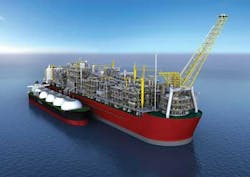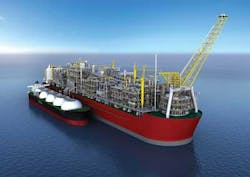Shell opts for offshore FLNG for Australia's stranded Prelude field
Construction is under way of the world's first offshore floating LNG (FLNG) facility. Under a consortium with Technip, Samsung is building the 488-m (1,601-ft) long, 74-m (243-ft) wide vessel in South Korea for Shell's Prelude project in the Browse basin off northwest Australia. It will be much bigger than any existing FPSO, weighing around 600,000 metric tons (661,387 tons) when fully laden.
Drydocks World in Dubai recently started work on the six modules for the 90-m (295-ft) tall, 30-m (98-ft) diameter internal turret at the front of the vessel, which will be fixed to the seabed via 4 x 4 mooring lines. SBM's design will allow the vessel to weathervane 360 degrees around the turret in response to prevailing winds and currents. According to Neil Gilmour, general manager FLNG at Shell Upstream International, sea states in the area are typically flat, although cyclones do pass through the basin each year. In general, however, conditions are fairly benign compared to other parts of Australia, and this stability will allow offloading alongside.
Shell is also confident that the vessel's robust design will allow it to withstand Category 5 storm conditions. "It's important to keep the FLNG unit in position," said Marjan Van Loon, VP LNG for Shell Global Solutions, during GE's annual industry conference in Florence earlier this year. "If you disconnect, you lose so much production, and that risks challenging the project's economics." The hull is designed for 50 years service, and the vessel should be able to remain at its offshore location for 25 years before returning to shore for inspection/refurbishment.
Shell discovered the Prelude gas/condensate field, 200 km (124 mi) offshore in 250 m (820 ft) of water, in 2007, and is targeting start-up within 10 years of the discovery. Development will also take in gas from the Concerto accumulation – the company and its partners aim to recover around 3 tcf of resources from the fields. At some point, Shell will look to tie in production from other fields in the area, assuming their gas composition fits the process facilities.
The vessel will have capacity to produce around 110,000 boe/d, and to convert this to 3.6 MMt/y of LNG, 1.3 MM t/yr of condensate and 0.4 MMt/yr of LPG. It will have storage for up to 220,000 t of LNG, 90,000 t of LPG and 125,000 bbl of condensate. Carriers will moor alongside periodically for offtake operations – LNG carriers will visit more frequently, perhaps once a week. The FLNG vessel will have four loading arms for LNG transfers and three for LPG, although typically three loading arms maximum will operate at one time.
Production risers will import gas through the turret swivels to the LNG processing train, with retrievable water intake risers drawing up seawater 150 m (492 ft) below the FLNG facility. "This is 10 degrees cooler than the temperature of the surface water, and will therefore help the cooling process," Van Loon said. Shell has designed a special integrated riser hanger assembly with guide sleeves to keep the risers together to avoid collision, and helical strakes to eliminate vortex-induced vibration.
For the onboard gas cooling operation, Shell will deploy the dual-mix refrigeration (DMR) technology that it has applied successfully on the Sakhalin II project offshore eastern Russia. "DMR operates in two cooling cycles to bring the temperature of the gas down to –160 °C [–76 °F]," Van Loon said. "The process requires only a very small inventory of refrigerants, and therefore cuts the equipment footprint and capex, as well as improving safety aspects on deck."
On arrival, the gas heads to a large inlet separator for removal of water and of condensates – the latter are stabilized and stored in the hull. The gas from the inlet section is routed to an amine absorber to remove the CO2 – according to Gilmour this is the single largest piece of equipment on the vessel. The gas is dried in three molecular sieves which adsorb the water molecules. The gas is then routed to a cryogenic section, where it is chilled to –160 °C to form LNG.
As with conventional FPSOs, the accommodation area and utilities modules will be located well away from the process facilities, at the vessel's rear. Additionally, there will be 20-m (65-ft) gaps on the deck between the main process modules to minimize the risk of escalation to other areas in case of leakages. The ventilation system should ensure that any explosive cloud that builds up disperses, Gilmour says, and the vessel's 150-m (492-ft) tall flare stack is also positioned well away from the facilities.
Transferring the process entirely offshore, Shell claims, will involve significantly less materials, land and seabed area than developing this volume of reserves via an onshore facility. Further, it will lessen the impact on coastal habitats, with no need for shoreline pipeline crossings or dredging work.
"This has been a long journey for us at Shell," said Gilmour. "Our engineers were talking about hybrid solutions for stranded gas prospects off Cameroon in the 1980s. The development really started in 1996 with studies for the Kudu field off Namibia, and later the Sunrise project off northern Australia and another in Nigeria. None got to the stage of Prelude, but through them we learned a lot."
Offshore Articles Archives
View Oil and Gas Articles on PennEnergy.com
About the Author
Jeremy Beckman
Editor, Europe
Jeremy Beckman has been Editor Europe, Offshore since 1992. Prior to joining Offshore he was a freelance journalist for eight years, working for a variety of electronics, computing and scientific journals in the UK. He regularly writes news columns on trends and events both in the NW Europe offshore region and globally. He also writes features on developments and technology in exploration and production.


